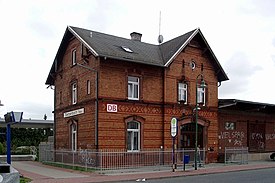Offenbach-Bieber – Dietzenbach railway line
| Offenbach-Bieber-Dietzenbach | |||||||||||||||||||||||||||||||||||||||||
|---|---|---|---|---|---|---|---|---|---|---|---|---|---|---|---|---|---|---|---|---|---|---|---|---|---|---|---|---|---|---|---|---|---|---|---|---|---|---|---|---|---|
|
Reception building of the Dietzenbach train station
| |||||||||||||||||||||||||||||||||||||||||
| Route number (DB) : | 3662 | ||||||||||||||||||||||||||||||||||||||||
| Course book section (DB) : | 645.2 | ||||||||||||||||||||||||||||||||||||||||
| Route length: | 9.6 km | ||||||||||||||||||||||||||||||||||||||||
| Gauge : | 1435 mm ( standard gauge ) | ||||||||||||||||||||||||||||||||||||||||
| Route class : | D4 | ||||||||||||||||||||||||||||||||||||||||
| Power system : | 15 kV 16.7 Hz ~ | ||||||||||||||||||||||||||||||||||||||||
| Maximum slope : | <15 ‰ | ||||||||||||||||||||||||||||||||||||||||
| Minimum radius : | 300 m | ||||||||||||||||||||||||||||||||||||||||
| Top speed: | 120 km / h | ||||||||||||||||||||||||||||||||||||||||
| Train control : | PZB | ||||||||||||||||||||||||||||||||||||||||
| Dual track : | Offenbach-Bieber-Dietzenbach center | ||||||||||||||||||||||||||||||||||||||||
| State (D): | Hesse | ||||||||||||||||||||||||||||||||||||||||
|
|||||||||||||||||||||||||||||||||||||||||
The Offenbach-Bieber – Dietzenbach railway branches off from the Rodgaubahn at Offenbach-Bieber station and leads via Heusenstamm to Dietzenbach . The route is integrated into the Frankfurt S-Bahn network. Line S 2 runs here.
history
The Offenbach-Bieber – Dietzenbach line connects to the Rodgaubahn, which opened in 1896, and was opened on December 1, 1898. It is the result of a long-lasting effort on the part of the local level since around 1870 to develop the area south of Offenbach by rail , which the Grand Duchy of Hesse took up very hesitantly. It took until 1888 for government approval and another ten years for the first train to run.
The trains initially ran in steam operation, and increasingly with diesel locomotives after the Second World War . The importance of the connection lay in the growing commuter traffic from the Offenbach district to jobs in the district town's leather goods industry .
On June 18, 1982, passenger traffic on the route was stopped and, apart from the trains used for the Hessentag 2001, only resumed in December 2003 after the route had meanwhile been used only slightly by rail freight traffic (by the so-called "Banana Express").
Conversion to S-Bahn standard
Already at the end of the 1950s, the establishment of an S-Bahn service on the route was discussed. However, it was to take until March 23, 2001 before a conversion of the connection to Dietzenbach into a double-track, electrified line within the Frankfurt S-Bahn network was started. An extension to the central Rödermark-Ober Roden train station via Rödermark- Urberach failed due to a lack of profitability.
The last kilometer between the Dietzenbach Mitte train station and the Dietzenbach train station stop was only a single track. The final stop is in the immediate vicinity of the Spessartviertel (formerly: "Starkenburgring"), a social hotspot known nationwide . After relevant incidents, the ceramic insulators on the overhead line masts of the railway were fitted with bulletproof metal plates facing the high-rise estate.
With the 2003/2004 timetable change on December 14, 2003, the S-Bahn began operating, the route was part of the S 2 S-Bahn line ( Niedernhausen –Dietzenbach) and thus became part of the S-Bahn network operated by DB Regio AG Rhine-Main integrated.
After the conversion to the S-Bahn, only a single siding remained in Dietzenbach-Steinberg. Until autumn 2008 this was only used by a fruit wholesaler for the purpose of supplying a hall for ripening bananas, which has now also switched to road freight transport .
literature
- Railway in Hessen. Cultural monuments in Hesse = monument topography Federal Republic of Germany , ed. from the State Office for Monument Preservation Hessen, Theiss Verlag Stuttgart, 2005, 3 volumes in a slipcase, 1,448 pages, ISBN 3-8062-1917-6 . Vol. 2.2, p. 810ff (section 066).
Web links
Individual evidence
- ^ Eisenbahndirektion Mainz (Ed.): Collection of the published official gazettes . Born in 1898, No. 53 of November 26, 1898, p. 357, Announcement No. 469.
- ↑ http://www.rodgau-s-bahn.de/de/de_steinberg.htm
- ↑ http://www.op-online.de/nachrichten/dietzenbach/industriegleis-ohne-kunden-276944.html

